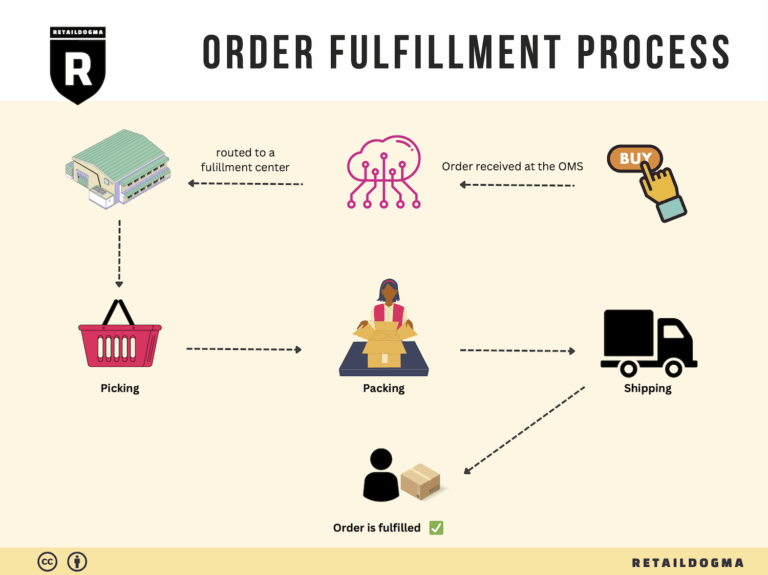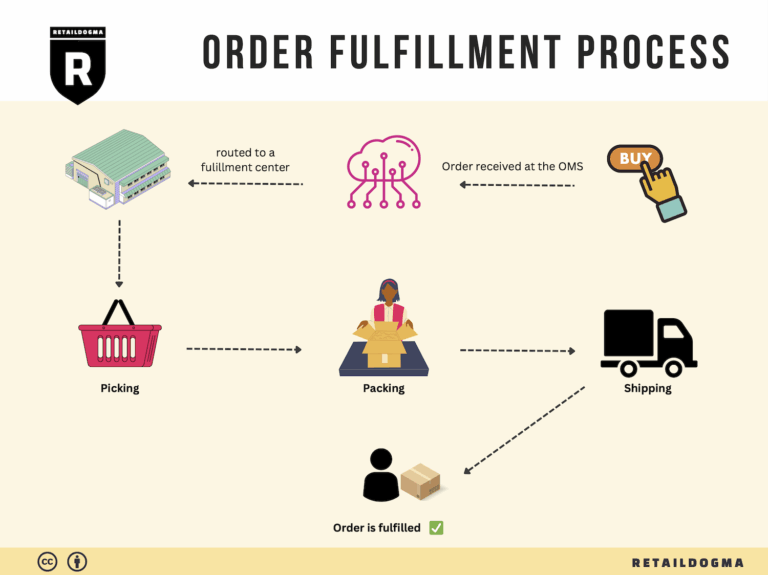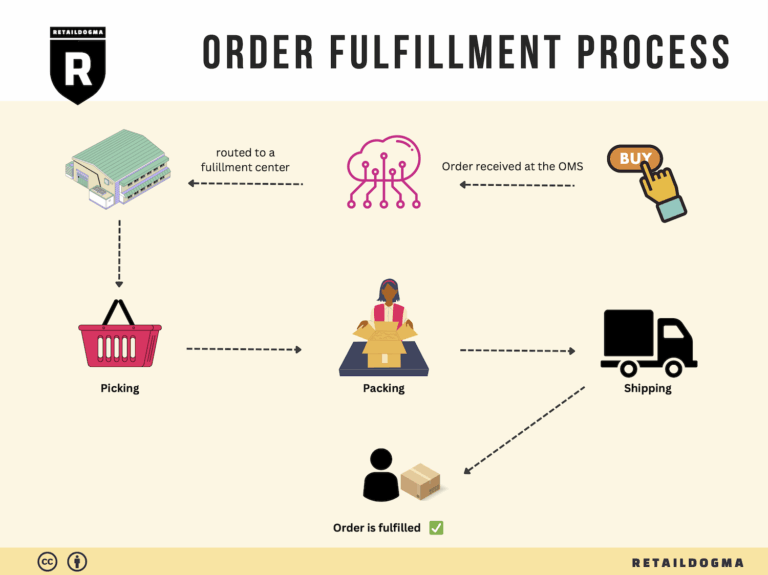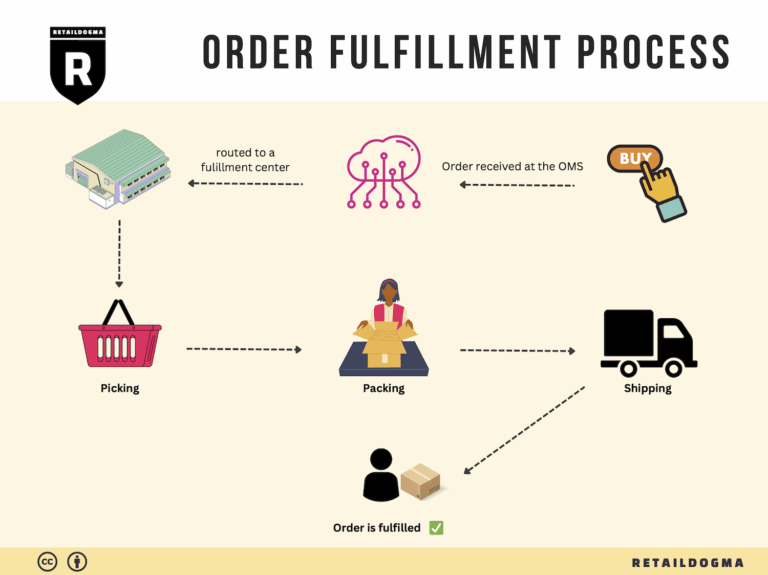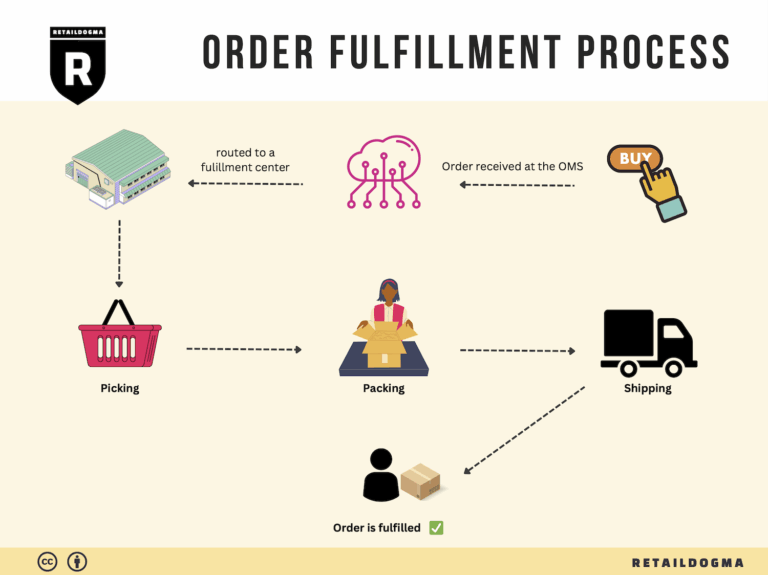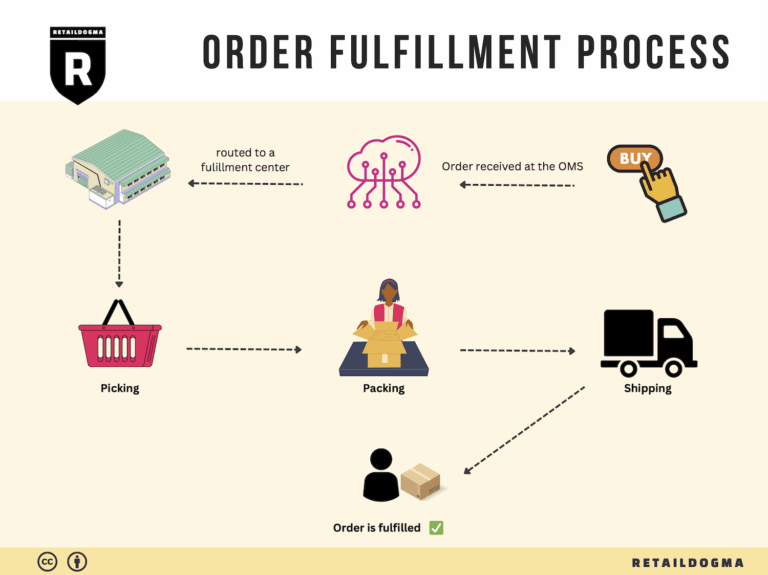What Is A Fulfillment Center? A Complete Guide (2025)
What is E-commerce Fulfillment? An Introduction for Growing Businesses
Understanding E-commerce Fulfillment: A Key to Scaling Your Business
As your e-commerce business grows, one common challenge many entrepreneurs face is the overwhelming task of packing and shipping orders. The excitement of increased sales can quickly turn into stress when you’re managing logistics, especially if you’re still handling fulfillment in-house. E-commerce fulfillment is the backbone of your business, encompassing the entire process of getting a product from your inventory to your customer’s doorstep. Understanding this process is crucial for scaling your operations effectively.
At its core, fulfillment involves several steps: receiving inventory, storing products, processing orders, packing items, and shipping them to customers. As your order volume increases, the complexity of these tasks can become daunting, leading to delays, errors, and ultimately, dissatisfied customers. This is where strategic fulfillment solutions come into play.
In this guide, we will explore the various fulfillment models available to growing businesses, including Third-Party Logistics (3PL) and Fulfillment by Amazon (FBA). Each model has its own set of advantages, allowing you to choose one that aligns best with your operational goals and customer expectations. We will also delve into the core services offered by fulfillment partners, such as inventory management, order processing, and returns handling, which can help streamline your operations.
Choosing the right fulfillment partner is a critical decision for your business. We will provide insights on what to look for in a fulfillment provider, including technology capabilities, scalability, and customer service. Pricing is another essential aspect; understanding the cost structure associated with different fulfillment models will empower you to make informed financial decisions that support your growth.
The goal of this guide is to equip you with the knowledge and tools necessary to navigate the complexities of e-commerce fulfillment. By the end of this guide, you will have a clearer understanding of how to optimize your logistics strategy, allowing you to focus on what you do best—growing your business and delighting your customers. With the right fulfillment strategy in place, you can turn the challenges of logistics into a competitive advantage.
What You’ll Learn In This Guide
- What is E-commerce Fulfillment? An Introduction for Growing Businesses
- The Order Fulfillment Process: From ‘Buy’ Button to Customer’s Door
- Comparing Fulfillment Models: In-House vs. 3PL vs. Dropshipping
- A Deep Dive into Amazon FBA: Pros, Cons, and Who It’s For
- Core Services Offered by Fulfillment Centers
- How to Choose a Fulfillment Partner: A 6-Point Checklist
- Understanding Fulfillment Pricing: A Breakdown of Common Fees
- Frequently Asked Questions (FAQs) about Fulfillment
- Conclusion: Is Outsourcing Fulfillment the Right Move for Your Business?
- Important Disclaimer
The Order Fulfillment Process: From ‘Buy’ Button to Customer’s Door
1. Receiving Inventory
The order fulfillment process begins with receiving inventory at the fulfillment center. This crucial step involves accepting products from suppliers or manufacturers and checking them against purchase orders to ensure accuracy. Each item is assigned a Stock Keeping Unit (SKU), a unique identifier that helps track inventory levels and sales.
Once the inventory arrives, it undergoes inspection for quality and quantity. Any discrepancies, such as damaged goods or missing items, are documented and addressed promptly. This step is vital because it lays the foundation for the entire fulfillment process. Accurate inventory management not only prevents stockouts but also ensures customer satisfaction by reducing the chances of backorders.
2. Warehouse Storage
After inventory has been received and verified, the next step is warehouse storage. Items are strategically placed in designated storage areas within the fulfillment center. Amazon utilizes a system of pods, which are shelving units that allow for efficient space utilization. Products are stored randomly within these pods to facilitate quicker retrieval during order picking.
The importance of this step lies in its impact on efficiency and order fulfillment speed. By storing items randomly, Amazon can reduce the time it takes to locate products when orders come in. The more organized and accessible the storage area, the faster the fulfillment process can proceed. This step is also where inventory management software plays a critical role, as it tracks the location and availability of each SKU in real-time.
3. Order Picking
Once a customer places an order, the next phase is order picking. This step involves retrieving the items from the warehouse to fulfill the order. Fulfillment centers often use pick lists, which are generated based on the items ordered. These lists guide workers or automated systems to the specific locations of each SKU within the storage area.
Order picking is a crucial part of the fulfillment process because it directly affects delivery speed and accuracy. Efficient picking systems, such as batch picking or zone picking, can significantly reduce the time it takes to gather items. As e-commerce businesses scale, optimizing the picking process becomes essential to meet increasing customer demands for fast delivery.
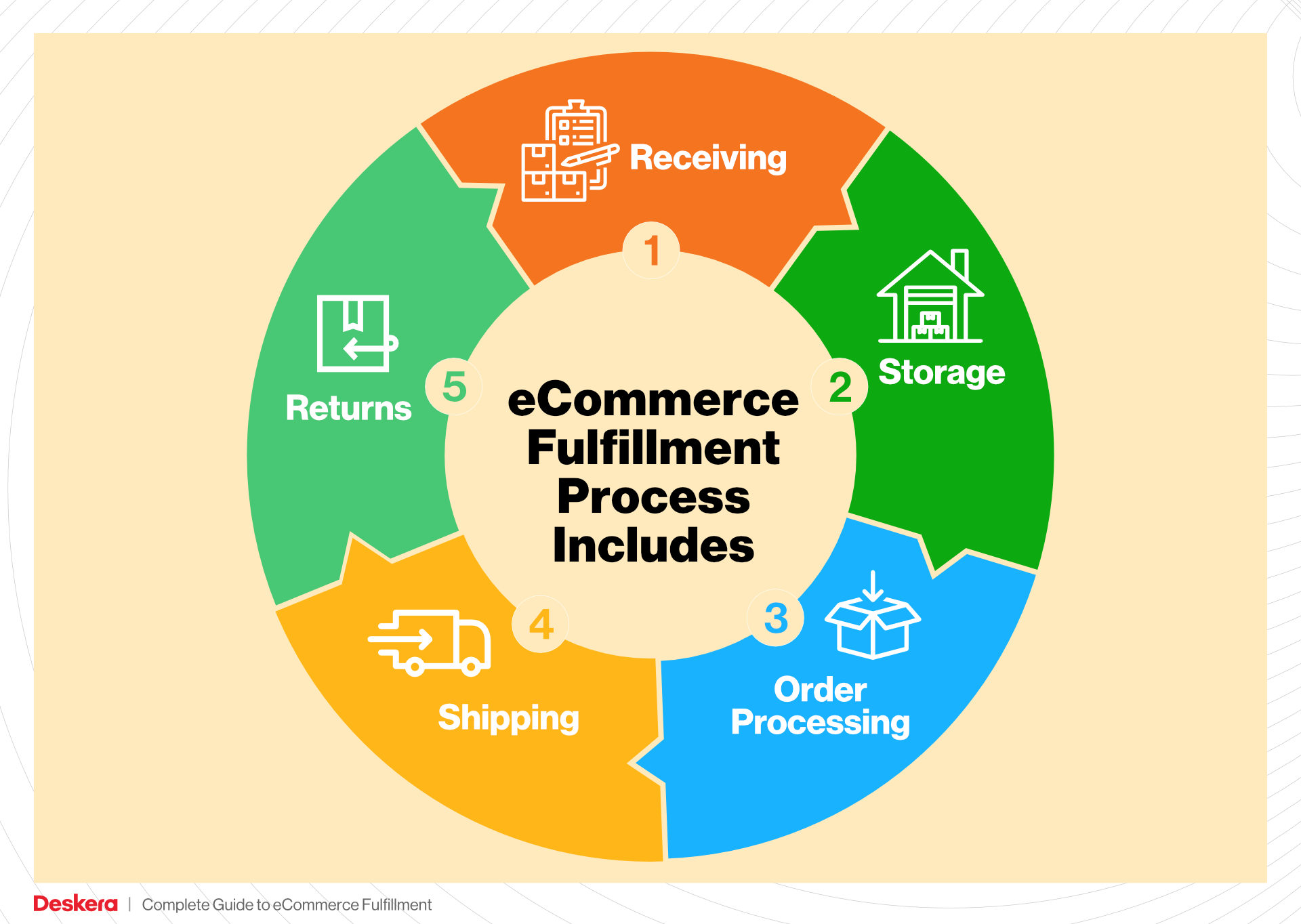
4. Order Packing
Once the items have been picked, they move to the order packing stage. Here, workers or automated systems carefully package the products for shipment. Proper packing is crucial to prevent damage during transit and to ensure that the correct items are sent to the customer. Each package is assigned a barcode sticker, which will later be scanned for tracking purposes.
This step is important not only for product protection but also for enhancing the customer experience. Packaging can be a reflection of a brand’s image, and well-packed orders can lead to positive reviews and repeat business. Additionally, efficient packing processes help minimize shipping costs and optimize space in shipping containers.
5. Shipping & Delivery
The final step in the order fulfillment process is shipping and delivery. Once packages are packed, they are sorted based on their destination and loaded onto trucks or planes for transport. Advanced logistics systems ensure that packages are dispatched in a timely manner, with tracking information provided to customers.
This phase is crucial for customer satisfaction. Fast and reliable shipping has become a key differentiator in the e-commerce market. Companies that can offer same-day or next-day delivery are often favored by consumers. The use of technology, such as route optimization software and real-time tracking systems, has transformed this step, allowing businesses to efficiently manage their logistics and keep customers informed throughout the delivery process.
Conclusion
Understanding each step of the order fulfillment process is essential for e-commerce business owners and operations managers looking to scale their logistics effectively. By optimizing each phase—from receiving inventory to shipping and delivery—businesses can enhance efficiency, reduce costs, and improve customer satisfaction, ultimately driving growth and success in a competitive marketplace.
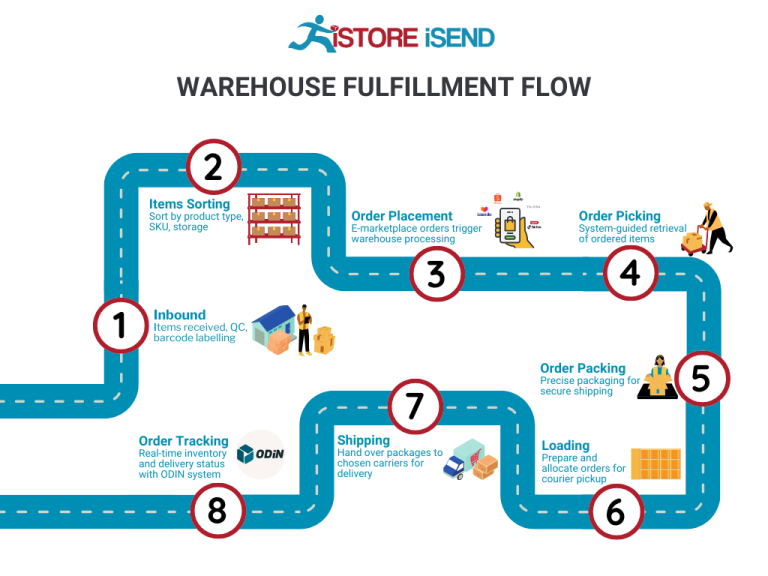
Comparing Fulfillment Models: In-House vs. 3PL vs. Dropshipping
Comparison of Fulfillment Models
| Model | Who Handles Inventory | Best For (Business Stage) | Key Advantage | Key Disadvantage |
|---|---|---|---|---|
| In-House Fulfillment | Business Owner | Established businesses with stable sales | Complete control over inventory and processes | High overhead costs and resource allocation |
| Third-Party Logistics (3PL) | 3PL Provider | Growing businesses seeking scalability | Access to expertise and infrastructure | Less control over inventory and potential hidden fees |
| Dropshipping | Supplier | Startups and small businesses with limited capital | Low upfront investment and low risk | Lower profit margins and less control over shipping times |
In-House Fulfillment
In-house fulfillment involves managing the entire inventory and shipping process within your own facilities. This model is ideal for established businesses that have a steady volume of sales and can afford the investment in warehouse space, staffing, and technology. The primary advantage of in-house fulfillment is the complete control it offers over inventory management, order processing, and customer service. This control allows businesses to tailor their logistics to their specific needs, ensuring high-quality service and quick response times to customer inquiries or issues. However, the key disadvantage is the high overhead costs associated with staffing, maintaining warehouse facilities, and managing logistics, which can strain resources, especially for businesses with fluctuating sales volumes.
Third-Party Logistics (3PL)
Third-party logistics (3PL) providers offer a scalable solution for businesses looking to outsource their fulfillment processes. This model is particularly beneficial for growing companies that need to expand their logistics capabilities without the burden of managing warehousing and shipping themselves. By partnering with a 3PL, businesses gain access to specialized expertise, advanced technology, and established infrastructure, which can significantly improve operational efficiency. Additionally, 3PLs can provide flexible solutions, allowing businesses to scale their operations according to market demand. However, a significant drawback of this model is the potential loss of control over inventory management and fulfillment processes. Businesses may also face hidden fees or service level discrepancies that can impact customer satisfaction.
Dropshipping
Dropshipping is a fulfillment model where the retailer does not keep products in stock but instead transfers customer orders directly to a supplier, who then ships the products on behalf of the retailer. This model is particularly well-suited for startups and small businesses with limited capital, as it requires minimal upfront investment and eliminates the need for inventory management. The key advantage of dropshipping lies in its low-risk nature; businesses do not have to invest heavily in inventory that may not sell. However, the primary disadvantage is that profit margins can be lower than in other fulfillment models, and retailers often have less control over shipping times and product quality. Delays or quality issues from suppliers can directly affect customer satisfaction, which is critical for building a successful e-commerce brand.
Conclusion
Choosing the right fulfillment model is crucial for scaling an e-commerce business. Each model—In-House Fulfillment, 3PL, and Dropshipping—offers unique advantages and disadvantages that can significantly affect operational efficiency, customer satisfaction, and ultimately, profitability. Businesses must assess their current stage, financial capacity, and growth aspirations to make an informed decision that aligns with their overall strategy. By understanding these models, e-commerce owners can implement a fulfillment strategy that best supports their long-term goals.
A Deep Dive into Amazon FBA: Pros, Cons, and Who It’s For
Understanding Fulfillment by Amazon (FBA)
Fulfillment by Amazon (FBA) is a logistics service provided by Amazon that enables sellers to store their products in Amazon’s fulfillment centers. This service allows Amazon to handle storage, packaging, and shipping for sellers, streamlining the order fulfillment process. When a customer orders a product, Amazon takes care of the entire process—from picking the item from the warehouse to shipping it directly to the customer. This service not only simplifies logistics for sellers but also leverages Amazon’s robust infrastructure, ensuring fast and reliable delivery.
How FBA Works
-
Product Listing and Storage: Sellers create product listings on Amazon and send their inventory to one or more of Amazon’s fulfillment centers. Amazon provides guidelines on how to prepare and label products before sending them.
-
Order Processing: When a customer places an order, Amazon’s system automatically picks, packs, and ships the product. This is done using advanced technology, including autonomous robots and conveyor belts, to optimize the process.
-
Customer Service and Returns: Amazon also handles customer service inquiries and returns for FBA orders, allowing sellers to focus on other aspects of their business.
-
Tracking and Reporting: Sellers have access to detailed analytics regarding their inventory, sales, and customer feedback, which aids in making informed business decisions.
Pros of Using FBA
Prime Eligibility
One of the most significant advantages of FBA is that products are eligible for Amazon Prime. This means that items can be delivered to Prime members with expedited shipping options, enhancing visibility and increasing sales potential. Prime members are known to spend more, making this a compelling benefit for sellers.
Customer Trust
Products fulfilled by Amazon often enjoy higher levels of customer trust. Amazon’s reputation for reliability and customer service translates to increased confidence among buyers when they see the “Fulfilled by Amazon” badge on a product listing.
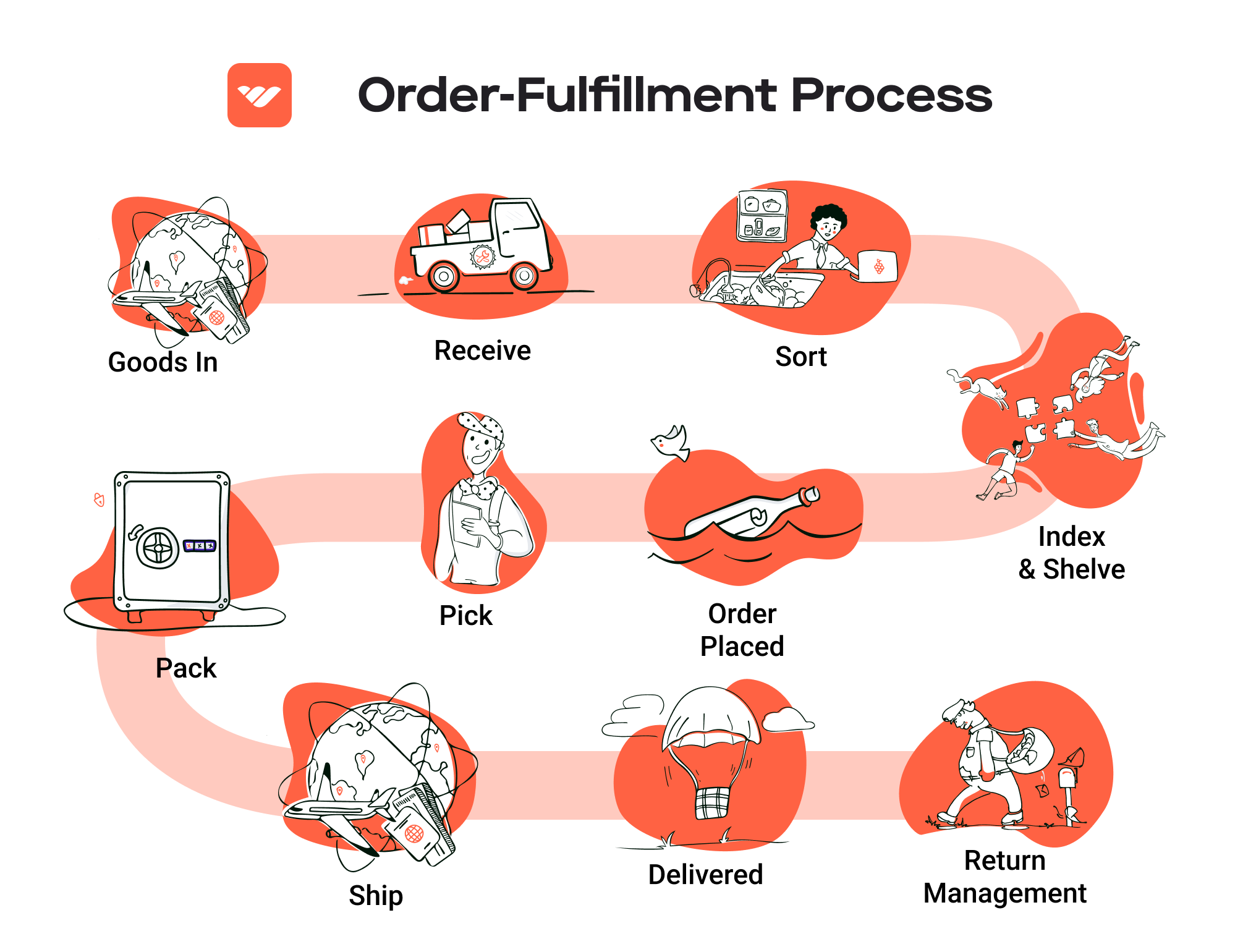
Multi-Channel Fulfillment
FBA is not limited to just Amazon sales. Sellers can utilize FBA to fulfill orders from other sales channels, such as their own websites or other online marketplaces. This flexibility allows businesses to centralize their inventory and streamline logistics across multiple platforms.
Simplified Logistics
FBA significantly reduces the burden of logistics for sellers. By outsourcing storage, packing, and shipping to Amazon, sellers can focus on other critical areas of their business, such as marketing and product development.
Scalability
As businesses grow, managing logistics can become complex. FBA allows sellers to scale their operations without the need to invest heavily in warehousing and distribution infrastructure. Amazon’s extensive network means that sellers can reach customers across various regions more efficiently.
Cons of Using FBA
High Fees
FBA comes with a variety of fees, including storage fees for keeping inventory in Amazon’s warehouses and fulfillment fees for each item sold. These costs can accumulate quickly, especially for sellers with lower-margin products, potentially impacting profitability.
Strict Inventory Rules
Amazon has strict policies regarding inventory management, including limits on how much stock sellers can send to fulfillment centers. Sellers must also adhere to specific guidelines for product preparation and labeling. Failure to comply can result in additional fees or the return of inventory.
Commingling Risks
When sellers use FBA, their inventory may be commingled with that of other sellers. This means that products could be shipped from different sellers, creating challenges if a customer receives a defective or incorrect item. This risk can be particularly concerning for sellers of unique or high-value items.
Limited Control Over Fulfillment
By outsourcing fulfillment to Amazon, sellers relinquish control over the shipping process. This can lead to variability in delivery times and handling, which may not align with the seller’s standards or customer expectations.
Inventory Management Challenges
While FBA simplifies logistics, it also requires sellers to manage their inventory levels carefully. Overstocking can lead to increased storage fees, while understocking can result in missed sales opportunities and potential loss of Prime eligibility.
Who is FBA Best For?
Fulfillment by Amazon is particularly beneficial for:
-
Small to Medium-Sized Businesses: Businesses looking to expand their reach without the complexities of logistics can leverage FBA to scale operations efficiently.
-
E-commerce Entrepreneurs: New sellers who want to enter the e-commerce space with minimal upfront investment in logistics will find FBA an attractive option.
-
Brands Focused on Customer Experience: Companies that prioritize customer satisfaction and want to offer fast shipping and reliable service will benefit from Amazon’s infrastructure.
-
Sellers with High-Volume Sales: Businesses that can maintain high sales volumes can absorb FBA fees more comfortably, making it a viable option for maximizing sales potential.
-
Multi-Channel Sellers: Those who sell on various platforms and want a centralized fulfillment solution will find FBA’s multi-channel capabilities advantageous.
In conclusion, Fulfillment by Amazon can be a powerful tool for e-commerce businesses aiming to streamline operations and enhance customer satisfaction. However, it’s essential for sellers to weigh the pros and cons carefully to determine if FBA aligns with their business model and growth objectives.
Core Services Offered by Fulfillment Centers
Inventory Management & Warehousing
Inventory management and warehousing are foundational services provided by fulfillment centers that play a critical role in e-commerce operations. These services involve the systematic tracking of inventory levels, orders, sales, and deliveries within a storage facility designed to house products efficiently.
What it is: Fulfillment centers utilize advanced technology and software systems to monitor inventory in real-time. This includes automated inventory tracking, barcode scanning, and stock level alerts to ensure that e-commerce businesses maintain optimal inventory levels. Warehousing services provide businesses with the physical space necessary to store products securely until they are ready to be shipped to customers.
Benefits: For e-commerce businesses, effective inventory management minimizes the risks of overstocking or stockouts, which can lead to lost sales and dissatisfied customers. With real-time inventory visibility, businesses can make informed decisions about reordering products, allowing them to respond quickly to market demand. Furthermore, using a fulfillment center reduces the need for businesses to invest in their own warehousing infrastructure, lowering overhead costs and freeing up capital for other growth initiatives.
Pick and Pack Services
Pick and pack services are a crucial aspect of the fulfillment process, directly impacting order accuracy and customer satisfaction.
What it is: This service involves the selection (picking) of products from inventory based on customer orders and then packaging (packing) those items for shipment. Fulfillment centers employ organized systems and trained staff or automated solutions to efficiently pick items from shelves and prepare them for delivery. This process often includes quality checks to ensure that the correct items are packed and ready for dispatch.
Benefits: By outsourcing pick and pack services to a fulfillment center, e-commerce businesses can significantly reduce the time and labor costs associated with order fulfillment. This efficiency not only accelerates the shipping process but also enhances accuracy, thereby minimizing returns and improving customer satisfaction. Additionally, fulfillment centers often have the capacity to handle large volumes of orders, which is particularly beneficial during peak shopping seasons.
Kitting and Assembly
Kitting and assembly services allow e-commerce businesses to offer customized products and bundles that enhance customer experience.
What it is: Kitting involves grouping multiple individual items into a single packaged unit, while assembly refers to the process of constructing products from various components. Fulfillment centers can handle both processes, allowing businesses to create product bundles, gift sets, or assembled products ready for sale.
Benefits: The ability to provide kitted or assembled products can differentiate an e-commerce business in a competitive market. This service not only streamlines the fulfillment process but also enables businesses to offer unique product combinations that appeal to customers. Additionally, kitting can lead to increased average order values as customers are often drawn to bundled offers. By utilizing fulfillment centers for these services, businesses can focus on marketing and sales rather than the logistical complexities of product assembly.
Returns Management (Reverse Logistics)
Returns management, or reverse logistics, is an essential service offered by fulfillment centers that addresses the challenges of product returns in e-commerce.
What it is: This service encompasses the processes involved in handling returned merchandise, including receiving returned items, inspecting them for quality, restocking inventory, and managing refunds or exchanges. Fulfillment centers have streamlined systems in place to efficiently process returns, minimizing the impact on operational flow.
Benefits: Efficient returns management is critical for maintaining customer loyalty and satisfaction. With a well-organized returns process, e-commerce businesses can quickly handle customer returns, ensuring that customers receive prompt refunds or exchanges. This responsiveness fosters trust and encourages repeat purchases. Moreover, effective returns management can provide valuable data insights regarding product performance and customer preferences, enabling businesses to make informed decisions about inventory and product offerings.
In conclusion, leveraging the core services offered by fulfillment centers—inventory management and warehousing, pick and pack services, kitting and assembly, and returns management—can significantly enhance the operational efficiency of e-commerce businesses. By outsourcing these functions, businesses can focus on growth strategies, marketing, and customer engagement while ensuring that logistics are handled by experts in the field. This approach not only improves service levels but also positions businesses to scale effectively in a competitive marketplace.
How to Choose a Fulfillment Partner: A 6-Point Checklist
Location & Warehouse Network
Choosing a fulfillment partner starts with understanding their location and warehouse network. The geographical placement of a fulfillment center can significantly impact shipping times and costs.
Why It Matters: A strategically located fulfillment center allows for faster delivery to your customer base, which is crucial in today’s fast-paced e-commerce environment. Shipping from a location closer to your customers can also reduce shipping costs, improving your bottom line.
Questions to Ask:
– Where are the fulfillment centers located, and how do they align with my customer demographics?
– What is the average shipping time to key markets?
– How many fulfillment centers does the partner operate, and do they have plans for expansion?
Technology & Integrations
In the age of automation and real-time data, the technology used by a fulfillment partner is paramount.
Why It Matters: Advanced technology can streamline operations, reduce errors, and provide you with real-time insights into your inventory and orders. A partner that offers seamless integrations with your existing e-commerce platforms can save you time and resources.
Questions to Ask:
– What software do you use for inventory management, and is it compatible with my e-commerce platform?
– Can you provide real-time tracking and reporting on shipments and inventory levels?
– Do you offer automated solutions for order processing and fulfillment?
Specializations (e.g., Cold Storage, Oversized Items)
Not all fulfillment partners are equipped to handle every type of product.
Why It Matters: If your business involves specialized items, such as perishable goods requiring cold storage or oversized items needing special handling, it’s essential to partner with a fulfillment provider that can meet these specific needs.
Questions to Ask:
– What types of specializations do you offer (e.g., cold storage, hazardous materials, oversized items)?
– What certifications or standards do you comply with for specialized handling?
– Can you accommodate seasonal fluctuations in inventory for specialized items?
Scalability & Capacity
As your business grows, so will your fulfillment needs.
Why It Matters: A good fulfillment partner should be able to scale with your business, providing additional capacity and resources as needed. This flexibility can prevent bottlenecks during peak seasons and help you manage growth effectively.
Questions to Ask:
– How do you handle increased order volumes during peak seasons?
– What is your capacity for scaling operations if my business grows rapidly?
– Are there limits on the number of SKUs or total volume you can handle?
Pricing and Contracts
Understanding the pricing structure and contract terms is crucial to ensuring your fulfillment partner aligns with your budget and business strategy.
Why It Matters: A transparent pricing model can help you avoid unexpected costs and ensure profitability. It’s also vital to understand the terms of service and any potential long-term commitments.
Questions to Ask:
– What is your pricing structure (e.g., per order, per item, storage fees)?
– Are there any hidden fees or surcharges I should be aware of?
– What are the terms of the contract, and is there flexibility for renegotiation?
Customer Support & Reviews
The quality of customer support can significantly affect your operations and customer satisfaction.
Why It Matters: Responsive and knowledgeable customer support can help resolve issues quickly and minimize disruptions. Additionally, reviews and testimonials from other businesses can provide insights into the partner’s reliability and performance.
Questions to Ask:
– What support channels do you offer (e.g., phone, email, chat), and what are your response times?
– Can you provide references or case studies from similar businesses?
– How do you handle complaints or issues that arise during the fulfillment process?
Conclusion
Choosing the right fulfillment partner is a critical decision that can influence your business’s efficiency, customer satisfaction, and ultimately, your profitability. By using this checklist, e-commerce business owners, operations managers, and entrepreneurs can make informed choices that align with their operational needs and growth objectives. Assessing these six key areas will help ensure that your fulfillment partner is a strategic ally in your journey to scale your business effectively.
Understanding Fulfillment Pricing: A Breakdown of Common Fees
Initial Setup Fees
When partnering with an Amazon fulfillment center, businesses often encounter initial setup fees. These fees can vary based on the complexity of your operations and the specific services you require. Initial setup may include costs for creating your seller account, integrating your inventory management system with Amazon’s platform, and any necessary training for your team on using Amazon’s tools.
Typically, these fees are one-time charges that can range from a few hundred to several thousand dollars, depending on the scale of your operation. It’s crucial to clarify what is included in the setup fee to avoid unexpected costs. For example, additional services like custom packaging or specialized labeling might incur extra charges.
Receiving Fees
Receiving fees are charged for the process of accepting and processing your inventory when it arrives at the fulfillment center. This includes unloading, inspecting, and sorting your products before they are stored.
The calculation of receiving fees generally depends on the volume of inventory being received and can be charged per pallet or per item. For instance, if you send a shipment consisting of multiple pallets, you may be charged a flat rate per pallet received. Understanding this fee structure is essential, as it can significantly impact your overall logistics costs, especially during peak seasons when inventory turnover is high.
Storage Fees (per pallet/bin)
Storage fees are incurred for holding your inventory within the fulfillment center. Amazon typically charges these fees on a monthly basis and categorizes them by the type of storage you require—standard or long-term.
Fees are calculated based on the volume of space your products occupy, usually expressed in terms of pallets or bins. For example, if you utilize a pallet of space in the warehouse, you would pay a predetermined fee per pallet each month. Long-term storage fees apply to inventory that remains in the warehouse for an extended period, often exceeding six months. This tiered pricing structure incentivizes sellers to manage their inventory effectively, reducing costs associated with excess stock.
Pick & Pack Fees (per item/order)
Pick and pack fees are charged for the process of selecting items from storage and packing them for shipment. This fee structure is crucial for understanding your per-order costs.
Typically, these fees are calculated on a per-item basis and may vary based on the size and weight of the items being picked. For instance, picking a small item like a phone case will usually cost less than picking a larger item like a television. Additionally, if you offer customized packing options, such as gift wrapping or branded packaging, these services may incur extra fees.
Effective inventory management can help minimize pick and pack fees. By consolidating orders or optimizing your product listings to reduce the number of individual items picked per order, you can control these costs.
Shipping Fees
Shipping fees are perhaps the most variable costs in the fulfillment pricing model. These fees cover the cost of transporting your products from the fulfillment center to the customer’s doorstep.
Shipping fees can be influenced by several factors, including the destination, the weight of the package, and the chosen shipping speed (e.g., standard vs. expedited). Amazon often offers tiered pricing based on shipping volume, meaning businesses that ship larger quantities may benefit from lower per-unit shipping costs.
To manage shipping costs effectively, consider utilizing Amazon’s Fulfilled by Amazon (FBA) service, which can provide competitive shipping rates due to Amazon’s scale and negotiating power with carriers.
Tips for Getting an Accurate Quote
When seeking a quote for fulfillment services, clarity and specificity are key. Here are a few practical tips to ensure you receive an accurate and comprehensive quote:
-
Detail Your Inventory: Provide a complete list of your products, including dimensions, weights, and any special handling requirements. This information will help fulfillment centers estimate receiving, storage, and shipping fees accurately.
-
Understand Your Needs: Be clear about your operational needs, such as order volume, seasonal fluctuations, and specific services (like custom packing). This will enable fulfillment centers to tailor their services and pricing to your business model.
-
Ask for a Breakdown: Request a detailed breakdown of all potential fees, including initial setup, receiving, storage, pick & pack, and shipping. This transparency will help you understand where costs may arise.
-
Compare Providers: Don’t hesitate to reach out to multiple fulfillment centers for quotes. Comparing offers can help you identify the best value for your specific requirements.
-
Negotiate: Depending on your expected volume, there may be room for negotiation on pricing, especially for storage and shipping fees. Establishing a long-term partnership may also lead to better rates.
By thoroughly understanding the fulfillment pricing model and being proactive in your negotiations, you can effectively scale your e-commerce business while managing logistics costs.
Frequently Asked Questions (FAQs) about Fulfillment
1. What is the Amazon Fulfillment Center MSP1?
The Amazon Fulfillment Center MSP1, located in Shakopee, Minnesota, is a large warehouse facility where Amazon stores products from various sellers. It utilizes advanced technology, including robotics and automated systems, to efficiently pick, pack, and ship items to customers. This center plays a critical role in Amazon’s logistics network, ensuring quick delivery times and high order accuracy.
2. How does the fulfillment process work at MSP1?
At MSP1, products are received from suppliers and stored in a system of shelving units known as pods. When an order is placed, automated robots retrieve the appropriate pod, allowing employees to pick the required items. These items are then packed into boxes, labeled, and sent out for delivery. The entire process is designed to optimize efficiency and minimize handling time.
3. What’s the difference between a warehouse and a fulfillment center?
A warehouse is primarily used for storage of goods, while a fulfillment center focuses on processing customer orders. Fulfillment centers are equipped with systems and technologies designed to efficiently pick, pack, and ship products directly to consumers, often involving real-time inventory management. In contrast, warehouses may not have the same operational focus on order fulfillment.
4. What is a 3PL (Third-Party Logistics)?
A 3PL provider is a company that offers outsourced logistics services, including warehousing, transportation, and fulfillment. E-commerce businesses often partner with 3PLs to manage their supply chain more effectively, allowing them to focus on core business activities while leveraging the expertise and resources of logistics professionals.
5. How much do fulfillment services cost?
Fulfillment service costs can vary significantly based on several factors, including the size and weight of the products, the volume of orders processed, storage fees, and additional services like packaging or returns management. On average, businesses can expect to pay between $2 to $5 per order, plus storage fees that can range from $0.10 to $0.50 per cubic foot monthly. It’s essential to compare different providers and services to find the best fit for your business needs.
6. What types of products can be stored at MSP1?
MSP1 can accommodate a wide range of products, from small electronics and household items to larger goods. However, there are restrictions on certain items, such as hazardous materials, perishables, and oversized items. Sellers should review Amazon’s guidelines to ensure their products are eligible for storage and fulfillment at this center.
7. How does Amazon ensure order accuracy at MSP1?
Amazon employs multiple systems to enhance order accuracy, including barcode scanning and automated inventory tracking. Each step of the fulfillment process is monitored, from receiving goods to packing orders, reducing the likelihood of errors. Additionally, advanced robotics help streamline the picking process, further minimizing mistakes.
8. Can I visit the MSP1 fulfillment center?
Yes, Amazon offers public tours of its fulfillment centers, including MSP1. These tours provide an inside look at how the facility operates and how technology is used to manage logistics. Visitors must sign up in advance, and tours are often limited to small groups to ensure safety and a quality experience.
9. What are the peak times for order fulfillment at MSP1?
Peak times at MSP1 typically coincide with major shopping events like Prime Day, Black Friday, and the holiday season. During these periods, the volume of orders can increase significantly, leading to higher demand for fulfillment services. Businesses should plan their inventory and fulfillment strategies accordingly to accommodate potential surges in orders.
10. How can I scale my business using Amazon’s fulfillment services?
To scale your business with Amazon’s fulfillment services, consider leveraging the Fulfillment by Amazon (FBA) program, which allows you to store your products in Amazon’s warehouses. This enables access to Amazon’s vast customer base and Prime shipping options. Additionally, optimize your product listings and inventory management to ensure you can meet demand efficiently. Regularly review analytics and customer feedback to refine your strategies and enhance your growth potential.
Conclusion: Is Outsourcing Fulfillment the Right Move for Your Business?
Evaluating the Benefits of Outsourcing Fulfillment
Outsourcing fulfillment can be a transformative decision for e-commerce businesses looking to scale efficiently. One of the primary benefits is time savings. By entrusting a fulfillment service with inventory management, packing, and shipping, you free up valuable time that can be redirected toward strategic growth initiatives, such as marketing, product development, and customer engagement.
Scalability is another significant advantage. As your business grows, so too do the complexities of order fulfillment. A proficient fulfillment partner can accommodate fluctuations in order volume, particularly during peak seasons or promotional events. This capability not only helps maintain service quality but also mitigates the risk of operational bottlenecks that could hinder customer satisfaction.
Moreover, partnering with experts in fulfillment allows you to leverage their knowledge and technology. Many fulfillment centers utilize advanced automation and logistics solutions, similar to those employed by industry leaders like Amazon, to optimize storage, reduce shipping times, and enhance overall efficiency. This expertise can often lead to cost savings and improved delivery performance that would be challenging to achieve independently.
Choosing the Right Partner for Growth
However, the success of outsourcing fulfillment hinges on selecting the right partner. It is crucial to evaluate potential fulfillment providers based on their capabilities, technology, and alignment with your business goals. A well-matched partner will not only streamline operations but also contribute to your brand’s reputation and customer experience.
Take Action
To determine whether a fulfillment partner is the right next step for your business, conduct a thorough audit of your current shipping processes. Assess your order volumes, fulfillment challenges, and growth projections. This analysis will provide insights into whether the benefits of outsourcing fulfillment can enhance your operational efficiency and support your growth strategy. Consider reaching out to potential partners for consultations to explore how they can tailor their services to meet your specific needs.
Important Disclaimer
⚠️ Important Disclaimer
The information in this guide is for educational purposes. Fulfillment services, pricing, and platform features change frequently. Always conduct your own due diligence and consult with providers directly before making business decisions.

